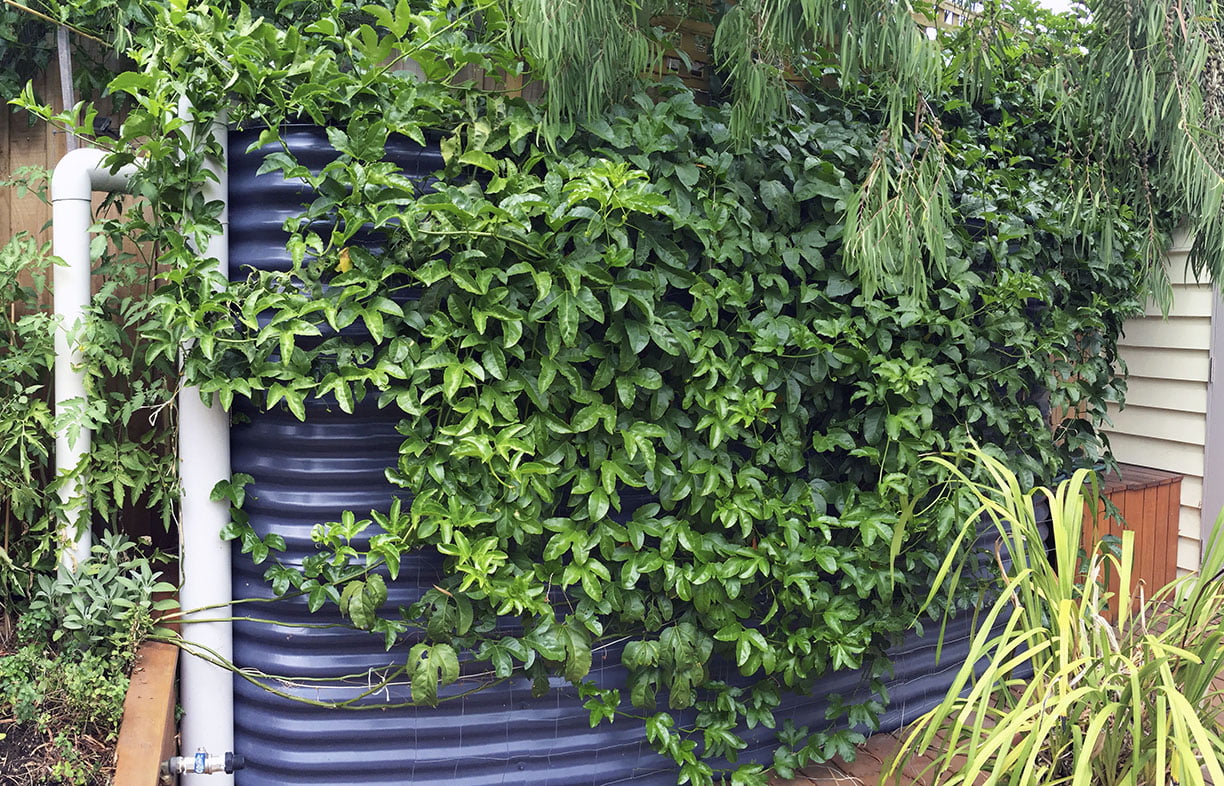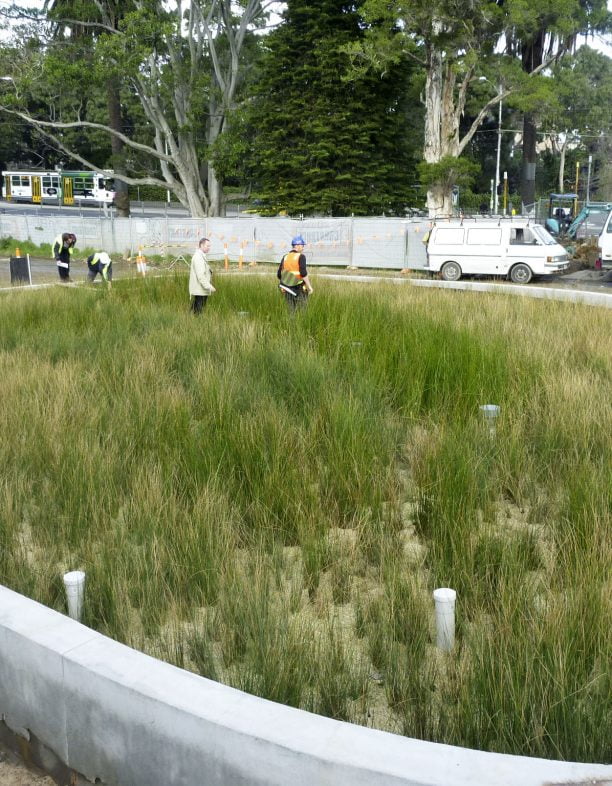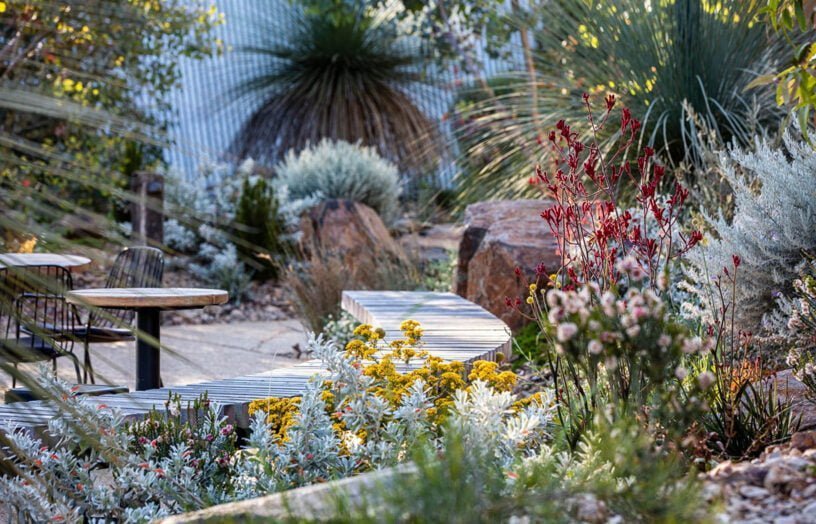Put your stormwater to use

Even dense inner-city housing can easily hold back most of its stormwater runoff—saving water, cooling cities, reducing flooding problems and protecting rivers. Chris Walsh’s inner-Melbourne house shows how.
Our little Richmond house needed renovating. In the process, I wanted to take the opportunity to practise what I preach in my work on urban stream ecology and show that a densely developed residential block can avoid contributing to the wrecking of my local river.
This would require two things: capturing runoff from all the hard surfaces of the property and using as much of it as possible. Ideally we would also allow some of the captured water to infiltrate into the surrounding soil, as rivers need groundwater flows, but as we are surrounded by constructions this wasn’t possible in our case.
However, if all properties could successfully keep most of their runoff out of the council drainage system, as we are doing, then it would become more feasible for councils to build infiltration systems that can cope with the large volumes of stormwater generated by roads. If this were done along all city streets, then our cities’ streams and rivers could be truly healthy again—a revival of natural assets that for too long we have assumed must be lost from our urban landscapes.
Just a square metre of runoff
So about 18 months ago as part of our renovation (and at little extra cost), we constructed two small, productive ‘rain gardens’ that capture runoff that would otherwise go into the stormwater drains.
These garden beds keep our household in herbs and vegetables (and provide cooling shade) without the need for mains water or active watering. We also installed a small rainwater tank that takes up less than 1% of the property area and captures water for use in our toilets, laundry and another garden bed.
Only a square metre or so of brickwork at the front gate drains to the street. With our stormwater system, no runoff should leave the property from any surfaces other than this square metre of brickwork, except in large storms.
The tank installation
Our house sits on a 160 m2 block, with a roof area (post-renovation) of 118 m2. To capture water from the roof, we installed a 2750 L slimline tank along the back wall of our courtyard. All the downpipes (draining about 114 m2 of roof) except one (draining 4 m2) drain to the tank via a ‘charged’ system (also known as a ‘wet’ system, the downpipes are always full up to the level of the tank inflow).
Each of the downpipes has a rainhead with a flywire screen to prevent debris flowing down the pipe and to keep out mosquitoes. This was particularly challenging for two downpipes on walls along the boundary, where we only had 150 mm between the wall and the boundary. I managed to source two frogmouth filters—narrow enclosed filters that are no longer manufactured. [Ed note: A product called Superdiverta, which sits flat against the wall, may be an alternative solution, www.supadiverta.com.au.] The small amount of water that splashes out of these filters is directed through a second pipe into the small garden outside our kitchen.
The 100 mm sewer-grade downpipes (necessary for charged systems) connect under the house to the tank. This pipe system has a slight slope to a purge point at the front corner of the house; in case the system ever needs to be emptied, it can be drained slowly into the front rain garden.
The tank is plumbed into our two toilets and washing machine. We also use it to water our 6 m2 of garden (normal garden beds, separate from the rain gardens described below), with a pump that switches automatically to mains water if the tank runs dry.
Productive rain gardens
The tank overflows to two connected rain gardens. It goes first to the 3 m2 back garden, which fills with water to about 15 cm higher than the water level in the 2.2 m2 front garden. When the back garden fills, it overflows to the front garden. When they were first connected, the back garden kept emptying to the same level as the front garden, because the pipe between them was acting as a siphon. A couple of small holes drilled into the top of the connecting pipe broke the siphon, and resolved this issue.
The rain gardens are essentially big planter pots, about 1 m deep, with a bottom layer of gravel separated from the top 60 cm of soil by geofabric. A slotted pipe, allowing water to pond up to about 40 cm depth, runs along the gravel layer connecting the higher inflow and outflow pipes. In a few places, the soil layer over the geofabric is sunk to the bottom of the garden to allow the soil to wick and keep the top soil moist when the water level drops. An inspection well (a capped, vertical 45 mm PVC pipe) in each rain garden helps us keep an eye on how much water they have over summer.
Because they are completely sealed at the bottom (with heavy-duty pond liner), the only loss of water from the rain gardens is from what the plants use. The current plants in these small rain gardens wouldn’t lose a lot of water over a year, but we are encouraging the plants to grow out of the beds: we planted a passionfruit vine that covers the tank and will grow along our back wall, grapevines that will cover the pergola in the rear courtyard, and trees. These big plants should at least triple the effective area of the rain gardens, absorbing much more water and providing lots of cooling shade.
The results
Over 18 months of operation, the tank has collected about 60 % of our roof’s runoff, and the rain gardens have used a further 10 %. Usage by the rain gardens should increase as the vines and trees grow. While our roof has produced runoff on 186 days over that time, the property has overflowed to the street only 44 times, usually releasing only a fraction of the volume running off the roof. On two days over that time, when flooding of Melbourne’s streets has been reported in the papers, our property produced little or no runoff.
During the last summer, a healthy stand of tomatoes used all of the water in the front rain garden twice (the deeper, back rain garden is yet to empty). The charged downpipes proved a useful resource, as we were able to fill the front rain garden from the purge point.
All of the vegetables and herbs we have planted in the rain gardens have thrived without active watering. A gingko tree and two citrus trees have been less happy, perhaps not enjoying having wet feet. We raised them after the first year, and are watching their progress.
The benefits of water saving, of low-effort fresh vegetables and herbs, and of cooling shade have made our system well worth our while, without even considering the public benefits we are providing by reducing local flooding and protecting our local river.
For more details of Chris’s rain garden renovation and progress, see www.urbanstreams.net/index.php/news-2/my-raingarden-diary. The urbanstreams.net site also contains more general information about his research on urban stream ecology as principal research fellow in the School of Ecosystem and Forest Sciences, University of Melbourne.
In my opinion, the sewerage systems of Australian cities do an excellent job of transporting the wastewater from our toilets, sinks and showers to central treatment plants that result in generally small, localised impacts to coastal waters or large rivers. In contrast, roof and road runoff drains to pipes and gutters that ensure every drop of rain that falls on a roof or road, every drop of oil or soapy water that spills onto the street, every dropping from a bird or possum that lands on a roof—all of it—drains quickly to the nearest creek, river or beach. This runoff causes the many waterways of our cities to be sick, failing to provide the many ecological services that healthy streams could.
If we keep stormwater on our properties, we can help reduce those widespread impacts. Using soapy greywater instead of stormwater to flush toilets will have no effect on the performance of treatment plants, but using it to water gardens will increase the risks of loading your soils with salts or of allowing high-nutrient greywater to get into the stormwater system.
The economics
The tank, pump, extra piping and additional labour added about $8000 to our renovation costs, amounting to less than $400 additional mortgage payments each year.
Personal savings to us exceed this outlay. The 40 kL of water supplied by the system saves us $100/year; the supply of herbs and vegetables has saved us at least $350/year at the market. We greatly value the shading benefits, which are more difficult to put a dollar value on.
We pay $95/year for Melbourne Water to manage our stormwater drainage and waterways (a fraction of what we pay them to protect the environment from the wastewater we produce). Our system is providing the public benefits of greatly reducing our property’s impact on our local waterway, and reducing our contribution to flooding. Arguably, a fair system of governance would compensate property owners who contribute to these services, making stormwater use even more economically attractive.
Historic, iconic and beautiful, the 26 acres of parklands on the eastern fringe of Melbourne’s CBD known as the Fitzroy Gardens require around 117 ML of water for irrigation annually. Challenged to meet this need in the face of drought, water restrictions and impacts of climate change, the City of Melbourne decided to build a stormwater harvesting system, following the success of their trial project at nearby Darling Street (you can read about this in ReNew 121).
Completed in December 2013, the Fitzroy Gardens system is, to date, the city’s largest, and captures sufficient stormwater to replace around 60% (i.e. 70 ML) of the potable water supply previously used on the gardens.
The water runoff is captured at a natural low point in the 67-hectare catchment area. The runoff first goes through a ‘gross pollutant trap’ to capture litter and leaves before moving on to the sedimentation chamber, which filters fine sands and oils. From there it flows into the primary 4 ML storage tank and gets pumped up to the biofiltration bed at the surface, planted out with native wetland grasses, where invisible pollutants such as nitrogen are removed. The treated water flows down to a 1 ML storage tank, from which the gardens’ irrigation water is drawn, with any excess diverted to the stormwater system.
Similar systems also operate in the Queen Victoria and Alexandra Gardens to Melbourne’s south, and Birrarung Marr on the banks of the Yarra River.
Indeed, local governments all around Australia are embracing Water Sensitive Urban Design practices to more effectively manage stormwater runoff in our urban landscapes. Water authorities are also encouraging rain gardens at the local level, providing step-by-step guides to designing, building and maintaining a rain garden (such www.healthywaterways.org, www.melbournewater.com.au/raingardens). South Australia’s Environment Protection Authority (www.epa.sa.gov.au) has Rain Garden 500, which is a three-year grant program for councils, community groups and individuals around Adelaide.

This article was first published in Renew magazine issue 135. Issue 135 is a water saving special.
RELATED ARTICLES
 Water saving
Water saving
Nurturing your native garden
Just how much maintenance do you need in a native garden? Robyn Deed gets some tips from landscaper Haydn Barling on how to sustain a beautiful, biodiverse garden in the suburbs.
Read more gardening
gardening
Working with contours
Sarah Coles speaks to Guildford local Louise Balaz-Brown about gardening in tough conditions, the importance of contours and the miracle of sheep manure.
Read more

